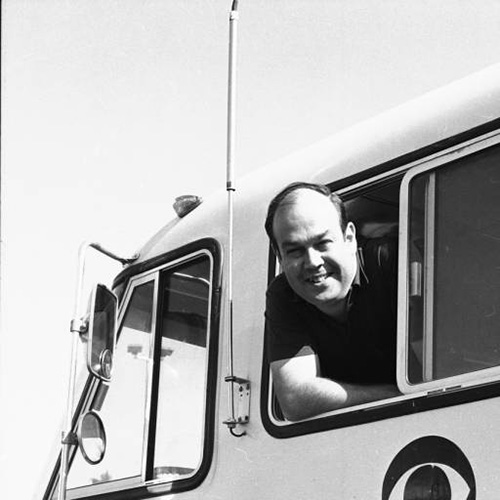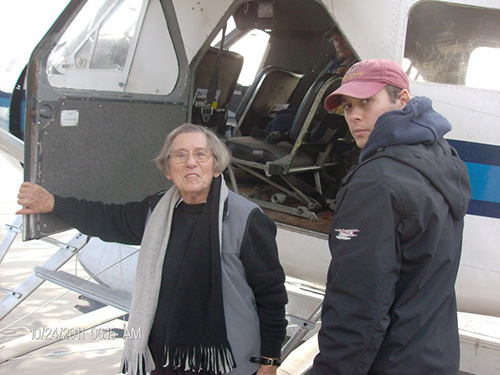
Visiting and Revisiting KetchikanTwo writers record their impressions of the First City, 16 years apartBy DAVE KIFFERNovember 24, 2015
Kuralt was very well known for his “On the Road” segments, which aired on the CBS Evening News from 1967 to 1994. When he retired in 1994, he published “America” which featured his 12 favorite places in America and Ketchikan – which he had visited several times - made the list.
Charles Kuralt in CBS News' "On The Road" van. Kuralt structured his book by visiting each of the 12 places a differen month of the year. For Ketchikan, he chose June. And the Ketchikan chapter opens in a familiar way. “It was raining in Ketchikan. This is like saying it was in hilly in San Francisco or crowded in Tokyo or romantic in Paris. It is always raining in Ketchikan.” He went on to note that June is traditionally the driest month in Ketchikan and it rained the entire time he was in the First City. Naturally, he waxed nostalgically about the rainforest, about Creek Street (“Part of the town’s charm is that it doesn’t seem quite respectable yet.”) about the fact you have to land your jet on a different island. At least one fact was not correct. Kuralt talked about the old days when you taxied your float plane up to the Front Street, deplaned, and walked across the street to the Ingersoll and the Gilmore. As far as can be ascertained, float planes almost never landed at the “downtown” docks, they landed in Newtown or Thomas Basin.
Inda Lou Schell in 2011 at Pacific Airways, Ketchikan “When the local government needs money, it sometimes goes out and cuts down some trees… Financially strapped places like New York City can wish they also had a few strands of Douglas fir (sic) to tide them over.” He wrote about the tourists flooding the city during the morning and early afternoon and then rushing back to their ships loaded down with “T-shirts, post cards, gold nuggets, Haida carvings and oosiks.” He wanders down to the docks and goes on about the tidal range, comparing Ketchikan’s “22 feet” to Key West’s “six inches.” He then exaggerates just a bit by noting that during significant storms “Ketchikan catches a thirty or forty footer.” On one of his walks around town he encounters then tour local operator Dave Button who has taken to wearing outlandish costumes (George Washington!) in order to attract passengers without actually violating the anti-solicitation law then in effect. He takes a “nature” tour with Button and then repeats much of Button’s running commentary, being careful to note the commentary is not necessarily factual. “He said the cannery was owned by the Japanese, he said the pulpwood production was owned by the Japanese,” Kuralt wrote. He said Ketchikan’s moderate climate is due to the Japanese Current. ‘The Japanese even own the current,’ he said. “ During his visit, Kuralt stayed at the Cape Fox Lodge and wrote admirably of eating in the well-lit restaurant, although he said calling it a “solarium” was ironic in place that gets so little sun. He wrote about watching carver Lee Wallace working on one of his totems for the Cape Fox roundabout. Later he visits the Totem Heritage Center just in time to sit and watch a recording of an On the Road segment he made in the early 1970s and he found it odd that the skinnier 35 year-old Charles Kuralt was explaining totem poles to the 59-year-old Charles Kuralt. He noted that he was happy to see several of the deteriorating totems from 1971 being kept in the Heritage Center. Originally Kuralt had planned, in 1995, to visit some other towns in Southeast, but discovered that all the ferry cabins were booked. So he flew to Juneau briefly and then Gustavus where he enjoyed the wilderness. He returned to Juneau and met a variety of local characters including Richard Harris, the great-great grandson of town founder Richard Harris, who found the first gold in 1880 with Joe Juneau. It being a century later, Harris was not a miner. He worked at K-mart, according to Kuralt. In following in Kuralt’s footsteps, Schell visited Ketchikan in September and October of 2011. Of course it is raining. “Today is Monday, September 26 and it’s raining. Tuesday – more rain. Wednesday – rain. Thursday – rain,” she writes. Initially, the rain keeps her somewhat inside she writes that she enjoys the Black Bear Inn, the B&B she where she stayed. She notes, admiringly, that Ketchikan residents go about their active lives in spite of the incessant rainfall. “Ketchikan would seem to be in the world’s least likely spot for a city,” she writes. “One’s first impression is that the city is built on stilts, half over the water and half on the steep mountainside.” While In Ketchikan, she visits Walmart but does get a little confused, placing it in the “mall” with McDonalds. She also attends a "Women of Distinction" Dinner. Since she has her own rental car, she spends a fair amount of time driving from one end of Ketchikan to the other. A favorite stop is Annabelle’s, where she is a big fan of the décor and the carrot cake. She also spends time at the Point, enjoying the music of Dave Rubin and the Potlatch Band. Like Kuralt, Schell is also interest in the native arts and the totem poles and notes the picture of Kuralt on the wall of the Totem Heritage Center. Unlike Kuralt, who only spent a week in Ketchikan during the visit for his book, Schell spend most of the month of October. That allows to her to get in a float plane trip to Prince of Wales, First City Players "Anything Goes"production, a talk about Ketchikan with Borough Assembly member Agnes Moran, a Halloween party at the Pioneer Home, the Annual Alaska Day Auction and plenty of time to explore the local history and to ponder on what makes Ketchikan, Ketchikan. Perhaps the biggest difference between the two accounts was that Kuralt seemed more interested in finding local color, while Schell seemed more interested in the people of Ketchikan. But both came away with a strong appreciation for Ketchikan and its unique – as far as Outsiders are concerned – history.
On the Web:
Contact Dave at dave@sitnews.us
Publish A Letter in SitNews Read Letters/Opinions
|
||

